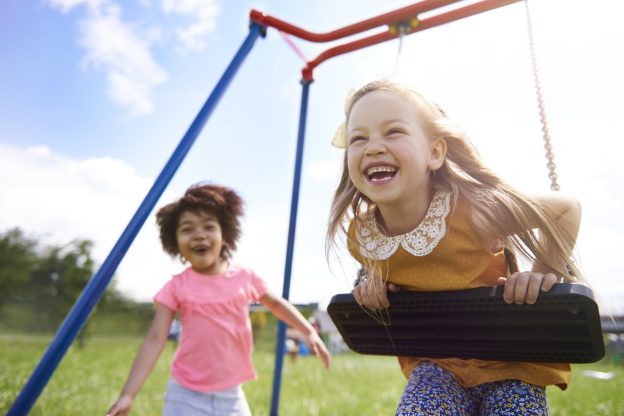
Parenting, Therapy Tips 
 For more from Shonna Tuck,
read Getting from Me to We:
How to Help Young Children
Fit in and Make Friends
For more from Shonna Tuck,
read Getting from Me to We:
How to Help Young Children
Fit in and Make Friends
8 Ways to Help Young Kids Make Friends This Summer (and Keep Them When They Go Back to School)
For young children, especially those who have finished their first year in school feeling emotionally and psychologically bruised, summer break can be a really important time to de-stress, rebuild self-esteem, and get some extra nurturing from family. After a week of chill time, some parents might be ready to reflect and ask themselves, "What might make next year better?" If you are reading this and quickly putting your fingers in your ears, saying "Nah, nah, nah, I can't hear you," I totally get it. It is more than okay to take a real break from it all and simply enjoy the time. Feel free to dig your toes in the sand, sip your fruity drink, and turn up the radio! No judgment, no pressure, no guilt. If you are reading this and thinking summer is a less busy time in which you can focus on what might make the next school year better, then here are some ideas to help your child connect with peers and, hopefully, begin to nurture some friendships that will extend to the classroom.1. First and foremost, play with your child for a set period of time every day.
It is easiest for kids who struggle with making and keeping friends to develop play skills they need with adults first. Good ideas for encouraging cooperative play include simple activities that require taking turns with high-interest toys, such as racing each other with two ramps and two Hot Wheels, taking turns with one Hot Wheel and a ramp, playing games like Pop-Up Pirate or KerPlunk, or building things together (such as forts). If your child needs to learn to include others’ ideas in play, you can help by following your child's lead (that might mean you don’t get to be Moana) but gently expand the play to include some of your ideas too. If your child needs to learn to solve social conflicts without yelling, abandoning, or hitting, you can practice gently changing a rule or taking an extra turn and provide opportunities for your child to learn to find a space to calm down, offer a trade, compromise, or explain the situation.2. Go to your neighborhood park regularly—preferably around the same time and day.
You are hoping to connect and establish relationships with other age-matched children in your community. Parks provide primarily sensory (sand, water, etc) and physical play that developmentally tends to be easier for young children struggling to connect and play with other kids. The best parks are those that are enclosed, and if not enclosed, not spread out so much that the kids aren’t really close enough to each other to facilitate interaction. You might have to start an awesome game of lava monster or avengers or whatever with your child to get other kids to notice and want to join in (think Pied Piper). Once momentum has gathered, try to work toward getting another child to take over your role and step out as soon as you can. Bring awesome toys that will draw other kids to your child. That might mean you bring a parachute, or a beach ball, or a big dump truck, or two big shiny shovels … or a really cute puppy. Whatever it takes! (You can, of course, just borrow the puppy.) Oh—and good snacks. If all else fails, everyone likes popsicles. Even if it just ends up to be you eating them. So be sure you like the snacks you bring …3. Go to summer camps that are hosted by local businesses, community centers, or churches.
The strategy here is to find connections that are close to home so that your child can develop friendships that have “roots” in their community. Ideally, camps you choose would have a low staff-to-child ratio and provide activities that hit just the right sensory balance of activity and rest and a good, predictable routine.4. Consider hiring a babysitter/peer mentor.
Think child labor … I mean, opportunity to develop responsibility and good work experience. You are preferably looking for a neighborhood child three or four years older than yours. Older children tend to be able to fill in the social gaps of younger kids and provide additional social practice for your child. This is mindful social engagement practice—meaning you will need to do some planning to ensure that your child is learning skills at the level he or she is at. Try planning out with your child activities that the two of them can do together. To keep the time positive, keep visits short—an hour or so. Encourage making a snack together, some outside time, and some special play time. To make sure your child wants to interact with this person, consider buying or borrowing some special activities that are used only when the mentor comes. Maybe a special Lego kit they do together (older child finds the pieces, your child puts them together) or a craft bin or Shopkins.5. Try to establish a connection with a child or two who will be in your child’s class in the fall—and then playdate the heck out of them!
Your goal is to help create a friendship with roots. Research indicates that kids who have even one friend who has their back are more protected from bullying because that friend is likely to be physically with your child, and more likely to defend your child. That willingness to stick your neck out for someone else does happen when special unicorn children just inherently do the right thing for others, even when they don’t know them. Thank God for them! But more often than not, standing up to a bully happens when true friends don’t want their buddy hurt. Just like adults, kids need fun, positive time with another person that is consistent over time. Otherwise, what we adults call “friends” are really just acquaintances (sorry to tell you, the little boy your child met at McDonald’s playland never to be seen again is not a “friend”). A real friend knows what your child's room looks like. A real friend knows what your child likes to do—and mostly likes to do the same things.6. Practice recess basics with your child.
Tag
Start with just you, and then add more people. If your child has difficulty tracking who is "it" when there are multiple people, consider videotaping the game (five minutes should do it). Then, at bedtime or a quiet time, review the video, pausing when a child is tagged. Ask your child who is "it." You would be surprised how many children leave kindergarten not really sure who is "it" when playing tag.Physical games
Your child needs to be able to take turns during activities, such as kicking a soccer ball in a net or shooting a basketball. You might also want to practice sabotaging the activity by taking an extra turn or two to enable a conversation about fairness and kids advocating for their own turns. Practice being a good sport by complimenting each other on good shots, good tries, etc.7. Turn off the Wi-Fi. Unplug this summer.
Seriously. If your young child is experiencing challenges connecting socially, it means that this is an area of struggle. It also means that your child needs extra practice playing and interacting with people. Real people, doing real things in real life. Many older, socially challenged people describe gaming, texting, and social media as the main way they connect with peers. The pressure to socialize digitally increases with age, which means that when kids are young in this electronic-pushing world, we need to protect the space of real time, dynamic, face-to-face interactions. This learning is sacred to being able to interpret the nuances of communication, such as body language, and to tune in to other people in action. Kids need to able to cope with boredom to create new ideas and to deal with not constantly being stimulated. Your teachers will thank you for this in September! Don’t worry; I don’t believe that any of us are now able to escape the digital landscape as we get older. Your child will certainly gain those skills, but when kids are young and vulnerable, they need to plug into their families and other kids more than anything else.8. Strengthen your relationship with your child.
School is not always the easiest place for some of society’s most interesting and needed people. Children build the strength and resilience they need knowing that they have a place at home and people at home who just “get them” and love them for themselves. This means creating an environment where you are free to say yes way more than “NO!”—where your child’s interests are encouraged and praised specifically (i.e. “I love watching you jump on the trampoline. You make it look so fun!” rather than “You are a good human.”) It also means recognizing when kids are doing their best, that they may have some challenges that other kids don’t, and that they need your patience and compassion even more than other kids. Try to find the good where and when you can—even if on some days, because you are human, you can only muster, “Hey, he breathed in and out consistently all day! That’s something!”



